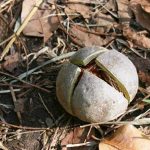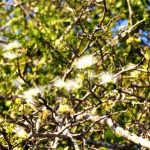TREE LIFE
February 1999
No 228
MASHONALAND CALENDAR
Tuesday 2nd February: Botanic Garden Walk weather permitting! Our walk in the economic section continues and we will also have a look at more of the little known and seldom seen species on Mark’s list. We will meet Tom in the car park at 4.45 for 5 p.m. – there will be a guard for the cars.
Sunday 21st February: Mr. David Wheeler’s Calgary Farm, close to Harare and with some interesting riverine vegetation, is this month’s venue. The area could be wet so wear suitable footwear, but should the selected spot be too wet there are plenty of drier places nearby to keep us occupied.
Saturday 27th February: Mark’s walk this month is at No. 34 Quendon Road in Mabelreign – the Meditation Centre for ROKPA Trust. There are 2 unspoilt acres of indigenous trees. Meet at 2.30 p.m.
Tuesday 2nd March: Botanic Garden Walk.
Easter April 2-5: A smallish group will be camping at Eastern Highlands Tea Estate in the Honde Valley. Please phone Maureen Silva¬-Jones for details and to reserve a place.
MATABELELAND CALENDAR
Sunday 7th February: An all day outing to Bambata Cave in the Matopos area. Meet at Girls’ College car park for an 8.30 a.m. departure.
Sadly our society has not been able to isolate itself from rising prices and it has become necessary to increase our subs to $80 per annum to keep up with stationary and postage costs which are our main expense. The effective date is 1 April 1999.
CLEVELAND DAM: Saturday 23rd January 1999
A group of about 12 people turned up at Cleveland Dam on a Saturday afternoon, which luckily in this monsoonal rainy season remained dry until the very end of the walk. We have not been to Cleveland for a while and one tends to think that like the Mukuvisi Woodland it is not of much interest. However, both places have a lot to offer, especially in the herbaceous flora.
One initial novelty was that two visitors from England were filming us. I think the idea was to show the eccentric European interests being practiced in Africa!
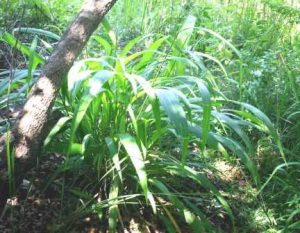
Setaria megaphylla.. Photo: Bart Wursten. Source: Flora of Zimbabwe
The basic plan of the afternoon was to walk below the dam wall. However, in the woodland edge quite close to the car park itself is a patch of a stout grass with broad pleated leaves. It is Setaria megaphylla. This is generally a forest edge species of the Eastern Districts and although it does rarely occur around Harare, in my view is probably planted or escaped here. Nearby was its smaller annual relative, Setaria homonyma, also with wide pleated leaves.
Nearby was Bracken, Pteridium aquilinum. This is a very successful plant, almost worldwide in its distribution. In Zimbabwe, it is probably most abundant in the Eastern Highlands, but it does occur in other wetter areas, for example along the main watershed. I would expect it to be a native plant, not introduced by man.
Also nearby was the now very common Bidens bipinnata. This is a new type of Blackjack that has exploded around Zimbabwe in the last two decades or so. The leaves are much more dissected than the normal blackjack, viz. Bidens pilosa, although they are not really dissected enough to be truly bipinnate. Like Bidens pilosa, it is a native of S. America.
Just below the dam wall is a fine tree of a Pod Mahogany, Afzelia quanzensis. I tend to think of this as a tree of lower altitudes and I do think it is commoner there, but isolated ones do occur at higher altitudes – this one at 1520m. We also saw one at Val D’Or near Ruwa at a similar altitude. One wonders if they could be planted and certainly at both sites there are numerous planted trees, so the idea is not impossible.
In the grassland on the sloping wall, we looked at a fine example of the stud-plant, Dicerocaryum senecioides. Both the slightly foxglove-like flowers and the disk-shaped fruits with 2 upward spines were to be seen. Further on, we found the white flowers of the perennial herb, Oxygonum dregeanum. Later, back at the car park we saw the other common Oxygonum, namely Oxygonum sinuatu. This is an annual species with very distinctive three-spined fruits.
In the woodland was Canthium lactescens. Squeezing the terminal bud produces a blob of white creamy milk; I assume that this feature is the origin of the specific name. As far as I know, this is the only Rubiaceae that does this (but I must admit I haven’t gone around squeezing their terminal buds) and indeed there is no milky latex in the family at all.
Emerging from the woodland, we admired a small legume, Desmodium barbatum. This generally has simple (1-foliolate) leaves, but one leaf was 3-foliolate – this feature of mixed leaf types occurs in other legumes and in other species of Desmodium.
The rain started as we left. It had been an interesting afternoon although it was really too wet to explore the vleis below the dam which would have produced even more of interest.
-Mark Hyde
SUFFRUTEX MOPANE
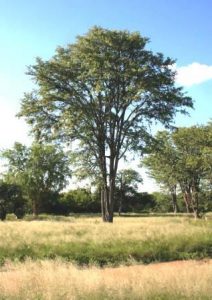
Colophospermum mopane. Photo: Bart Wursten. Source: Flora of Zimbabwe
In Zimbabwe, Mopane (Colophospermum mopane) exhibits a remarkably wide range of adaptability to climate and soil. Common in the low hot dry country where annual rainfall is only some 250mm, the species extends up the watershed to occur occasionally in better-watered areas where rainfall may exceed 750mm per annum. This reflects an increase in altitude from 300 to 1200 meters above sea level with a 5°C drop in mean temperature. Typically Mopane occurs on poorly drained alkaline soil of various textures and depths but less commonly it can also be found on good arable class land.
Given this wide variation in habitat, the growth forms or Mopane vary from strong woodland on the better soils through to stunted scrubland common in arid areas on shallow soils of poor water holding capacity. Heavy browsing pressure by elephants, as is common in the vicinity of watering points in our National Parks, also results in stunting.
However, there is a further form of natural stunting which is ecologically puzzling. This is referred to as the suffrutex habit where a few stems, each only a meter or two long, grow from perennial woody groundstocks in pure stands of a few square meters to many hectares in extent. The stems remain short and appear to die off within a few seasons being replaced by new and similar growth from the groundstocks, which remain prostrate on the soil. The growth of the stock is horizontal along the soil surface and it may be contorted and branched to some degree. Where it is in contact with the underlying soil, the stock has bark from which the roots and shoots emerge but the upper surface of the stock is commonly free of bark exposing a highly weathered and contorted woody grain making for attractive pieces of “driftwood”.
The suffrutex growth form is commonly encountered in the SE Lowveld where it is associated with the wide belt of basalt soils stretching from Chisumbanje in the Save Valley to the Mateke Hills near the Bubye River.
The actual physiological processes giving rise to the suffrutex growth habit in Mopane are not clearly understood although they are thought to be linked with the seasonal waterlogging, the alkalinity, and the self churning nature of these heavy clay soils. The seasonal waterlogging and alkalinity would tend to inhibit normal perennial tree growth while it is also suggested that the severe cracking of these basalt clay soils on drying out may rupture roots and so check growth. The stems, being temporary, remain immature.
Presumably, if the drainage were to improve, more normal tree growth would occur in the suffrutex Mopane. There is some evidence to support this supposition which can be seen alongside the road between Rutenga and Bubye particularly in the vicinity of Alko Ranch where several areas of typical suffrutex growth can be seen quite readily as one travels along. In places the road was constructed through these areas about thirty years ago with the result that the mopane growth near the road is now significantly taller and more tree-like presumably due to the improved drainage on the roadside verge. This would tend to suggest that poor seasonal drainage in the soil is the principal factor in the development of the suffrutex growth habit in Mopane.
-John Wilson
THE RAIN FOREST AT VICTORIA FALLS
On the east, parallel with the Falls, and some forty-five paces to the south of them, ran the glorious forest which may not inaptly be called the “rainforest’, its luxuriance being the result of the continual showers of spray…
EDUARD MOHR – TO THE VICTORIA FALLS OF THE ZAMBEZI. 1876.
Countless thousands of tourists have visited the Victoria Falls since they were brought to the notice of the outside world by David Livingstone and others, and have tramped through the rainforest searching out every possible point from which to view the Falls. But how many of these tourists have turned away from the main attraction for a moment to look at – and see – the trees and shrubs and herbs of the rainforest?
This forest is unique in Zimbabwe, not because of its constituent species, but because of the great volume of spray that rains on it from the Falls. The rainforest is merely an unusually extensive area of riverine forest, but it is the continuous spray that makes its existence possible in the very shallow soil overlying the old riverbed. There must have been rainforest at each of the previous seven fall lines, but each time the falls retreated the forest would have died without its life-sustaining spray, and a new forest would have developed at the new fall line. This process, has been going on for about two million years, and will be repeated once or twice more in times to come for two other lines of weakness are apparent in the basalt rock of the riverbed upstream of the present-day Falls, and perhaps both are future fall-lines.
Today’s rainforest can be divided into three zones according to the nature and volume of spray from the Falls. There are no great differences in tree species present in each of the zones, but their frequency does vary. Opposite the Devil’s Cataract is a zone of drier forest where the spray fluctuates seasonally according to the level of the Zambezi River. Further east, opposite the Main Falls, the forest is very wet throughout the year from fairly continuous spray regardless of river level. In this zone some of the trees develop buttress roots, an adaptation that is common in tropical rainforests to prevent trees from falling over or sinking in wet soil. Further eastwards still, from opposite Nyamakabwa Island (Livingstone Island), the forest thins out, and then gives way to grassland with scattered clumps of palm, shrubs, and small trees. This region is probably subject to the greatest fluctuations in the volume of spray, varying between complete waterlogging when the river is full to little or no spray for the rest of the year. But the absence of complete forest cover here is not fully understood.
Among the more prominent trees in the rainforest is Diospyros mespiliformis, the tall and black-barked wild ebony or African ebony. Unlike the fabled ebony of India and Sri Lanka, Diospyros ebenum, our species does not consistently have black heartwood. Equally prominent is the common red milkwood, Mimusops zeyheri, another black-barked tree, but not so tall as the first. Two waterberries are also present, Syzygium cordatum and Syzygium guineense subsp. barotsense, and the African mangosteen, Garcinia livingstonei, occurs throughout the forest, but is not found so frequently; it has a pale yellow latex that exudes from wounds to bark or leaves. Less common still is the grape Strychnos, Strychnos potatorum, easily recognized by its three-veined leaves and its round, fleshy, blue-black fruit about the size of a small plum. The wild olive, Olea europaea subsp. africana, is one of the more common of the small trees, with olive-like fruit and narrow dark green leaves with silvery, golden, or brown scales on the undersides. The well-known Natal mahogany, Trichilia emetica, is common in the forest, and two wild figs are easily recognized – the red-leaved rock fig, Ficus ingens, a good example of which may be seen at the viewpoint directly opposite the Devil’s Cataract, and the Cape fig, Ficus sur, with large edible fruits that are so much favoured by the trumpeter hornbill. The wild date palm, Phoenix reclinata, is common in the rainforest proper, and very numerous in the grassland opposite Nyamakabwa Island and the Horseshoe Falls.
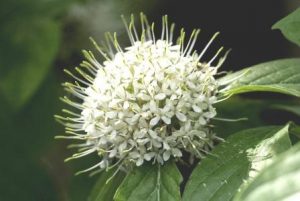
Pavetta cataractarum. Photo: Bart Wursten. Source: Flora of Zimbabwe
Beneath the canopy of the rainforest is a well-developed shrub layer containing about 70 species, among them Pavetta incana, with its masses of white flowers, in the wetter parts of the forest; this was formerly named Pavetta cataractarum in honour of the Falls. And beneath the shrub layer is the herbaceous flora, with a wealth of about 150 species, many of which have been recorded from nowhere else. Our national flower, the flame lily, Gloriosa superba, is to be found here, sometimes festooning the shrubs; also the rare black arum, Amorphophallus abyssinicus, in shady places. In the early part of the rainy season the fireball lily, or pincushion flower, Haemanthus filiflorus, with its large red globes of slender flowers, may be conspicuous in the undergrowth; and a little later in the season the large white flowers of a ground orchid, Calanthe natalensis, will briefly adorn the forest floor. Ferns can be seen the year round; the well-known maidenhair, fern, Adiantum cappillus-veneris, is fairly common, but there is also the rare Cheilanthes farinosa, known only from here and from two places in Zambia, whose fronds are a striking sulphur-yellow colour on the undersides.
But the rainforest at Victoria Falls is more than just a rich collection of plants: it is a complete ecological system. And there is much else in the forest for the visitor to see – birds, insects, reptiles, and mammals. Most visitors to the Falls will probably have seen bushbuck and baboons in the forest, sometimes a banded mongoose, but other animals may also leave their footprints there – waterbuck, hippo, even leopard. The patient visitor might be rewarded with a good view of the shy, but spectacularly beautiful local variant of the Knysna Lourie, formerly known as Livingstone’s Lourie . The rare Taita falcon may sometimes be seen if one is very lucky; Heuglin’s robin is quite common; and the paradise flycatcher is present during the summer months. The trumpeter hornbill, a large black-and-white bird with an enormous beak, is very common, especially when the wild figs are ripe.
Like most ecological systems the rainforest is fragile, and even the pressure of human feet began to cause damage many years ago, leading to the construction of concrete paths through the forest to the various viewing points, from the Devil’s Cataract to Danger Point. It is not only illegal to leave the paths; it may also be dangerous to one’s life. The severe dry cycle of the 1980s and 1990s had its impact on the rainforest. Lower-than-usual river levels resulted in reduced spray from the Falls, and many trees in the forest died – just a foretaste of what will eventually happen to this unique part of Zimbabwe’s heritage of trees when the Zambezi cuts a new fall-line at some still distant era in the future. But, in its own good time, a new rainforest will develop for future generations in this land to enjoy.
-Lyn Mullin
Bill and Joey Edwards from Chinhoyi ask if anyone knows ‘the origin and history of the large (Acacia) Faidherbia albida in the grounds of the Trauma Centre, East Road in Harare. It is a magnificent specimen and seems to be of quite an age. It must have been planted there, as it is right out of its environment in Harare!
Well, one suggestion which comes from Mr. Ronnie James is that the tree could have been planted in the 1930s by the then owner of the property, perhaps encouraged to do so by his neighbour – Mr. Alec Haddow who was a councillor at the time, and who was also a great tree enthusiast.
Any further ideas? Share them with the rest of us by dropping a line to P 0 Box 2128, Harare. We would also like to read about other outstanding or unusual species spotted on your wanderings.
ECONOMIC POTENTIAL OF SOUTH AFRICA’S BOTANICAL RESOURCES
A report in the December 1998 issue of Technobrief, the monthly newsletter of South Africa’s council for Scientific and Industrial Research, (CSIR) describers the Councils’ plans to obtain benefits from the country’s biodiversity.
South Africa has an estimated 23 000 indigenous plants, representing nearly 1% of all plants known to man.
A bio-prospecting consortium aims to increase the number of plants investigated for commercial use from 5% to 15%.
Members of the Consortium include the CSIR, the Agricultural Research Council, the Medical Research Council, the National Botanical Institute and 3 universities.
The programme wishes to unlock the medical, biopesticidal, nutraceutical and genetic potential of South Africa’s plant kingdom.
One species has already been identified as a source for the first major drug from an African plant. It is an anti-obesity compound with a potential market of US$3 billion. This will provide the CSIR and the consortium with substantial royalty income.
-Andy McNaughtan
Our Solitary Juniper – How Did It Get Here?
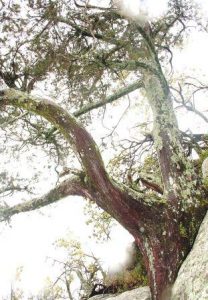
Juniperus procera. Photo: Bart Wursten. Source: Flora of Zimbabwe
On 23 October 1965 Dr. Hiram Wild and Mr. Norman Chase collected the first specimens of Juniperus procera from a single tree on Nyahokwe Mountain. Since then, a number of members of the Tree Society have seen the tree, but to this day it remains the only known specimen of the species in Zimbabwe, and the nearest other specimens are in northern Malawi, some 900km away. So how did our specimen get here? A relic of a former larger population, perhaps? We shall probably never know for sure, but I had a very interesting discussion in the Botanic Garden on 28 December 1998 with a visiting American, Martin Christ, from West Virginia. He is a plant physiologist, and had been involved in a study of the dispersal of Juniperus seed in the south-eastern United States. They found that birds were among the most important agents. This was a very interesting thought, so I checked it out in one of my reference books (Silvics of Forest Trees of the United States) and, sure enough, there it was; Juniperus virginiana (eastern red-cedar) “small mammals and many species of birds, including quail, grouse, pheasant, and turkey feed on the fruit and aid in the dispersal of the seed”; Juniperus scopulorum (Rocky Mountain juniper) “seeds are disseminated primarily by birds… lines of bird migration, number of birds, prevalence of juniper berries, and scarcity of other food are undoubtedly factors that affect distribution”; Juniperus occidentalis (western juniper) “both birds and mammals eat the berries and thus play an important part in the dissemination of seed.”
I remember discussing our lone juniper with Jonathan Timberlake a couple of years ago, and he thought it might not be indigenous, but traceable back to Arab traders or slavers. That, too, was an interesting idea, but I am now inclined to believe that a migratory bird was more likely to have been responsible. This, of course, does not answer the question – why only a solitary specimen? So, is it there by accident? Is it a relic of a larger population? Are there possibly other specimens on mountain escarpment immediately to the east of Nyahokwe? Any one with any ideas?
Pine Ester Can Reduce Cholesterol
The September [1998] issue of WOODSHOP NEWS reports that American woodworkers interested in cutting their cholesterol can take a break from cutting the pine boards on their table-saws to indulge in some of the pine ester on the kitchen table. According to the report by Melanie Winters, pine ester, a by-product of the pulp industry, is being used as a dietary ingredient in the manufacture of cholesterol-cutting food products. Some of these foods were expected to hit the United States market late this year.
The proprietary process involves using sitostanol ester, an esterified natural plant alcohol derived from phytosterol, a pine oil and a by-product of the pulp industry. Researchers from the Raisio Group of Finland figured out a way to extract the sitostanol and mix it with conventional margarine, which the company called Benecol. Regular use of this product has been found to reduce cholesterol levels by an average of 12% by inhibiting its absorption into the bloodstream. Full-scale production is expected to come on stream early in 1999.
-Lyn Mullin
ANDY MACNAUGHTAN CHAIRMAN


